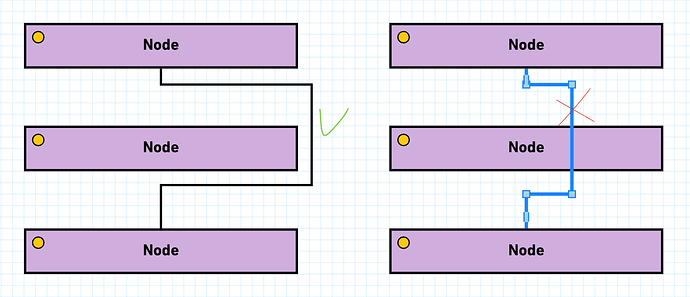See if this improved version of SnapLinkReshapingTool works for you. This is just the plain ES5 JavaScript version of extensions/SnapLinkReshapingTool.js. Ultimately these changes will go into the extensionsJSM and extensionsTS directories too. Eventually.
"use strict";
/*
* Copyright (C) 1998-2020 by Northwoods Software Corporation. All Rights Reserved.
*/
// A custom LinkReshapingTool that snaps dragged reshaping handles to grid points.
/*
* This is an extension and not part of the main GoJS library.
* Note that the API for this class may change with any version, even point releases.
* If you intend to use an extension in production, you should copy the code to your own source directory.
* Extensions can be found in the GoJS kit under the extensions or extensionsTS folders.
* See the Extensions intro page (https://gojs.net/latest/intro/extensions.html) for more information.
*/
/**
* @constructor
* @extends LinkReshapingTool
* @class
* This SnapLinkReshapingTool class supports snapping reshaping handles to go to the nearest grid point.
*/
function SnapLinkReshapingTool() {
go.LinkReshapingTool.call(this);
/** @type {Size} */
this._gridCellSize = new go.Size(NaN, NaN);
/** @type {Point} */
this._gridOrigin = new go.Point(NaN, NaN);
/** @type {boolean} */
this._isGridSnapEnabled = true;
/** @type {boolean} */
this._avoidsNodes = true;
// internal state
this._safePoint = new go.Point(NaN, NaN);
this._prevSegHoriz = false;
this._nextSegHoriz = false;
}
go.Diagram.inherit(SnapLinkReshapingTool, go.LinkReshapingTool);
/**
* Gets or sets the {@link Size} of each grid cell to which link points will be snapped.
* The default value is NaNxNaN, which means use the {@link Diagram#grid}'s {@link Panel#gridCellSize}.
* @name SnapLinkReshapingTool#gridCellSize
* @function.
* @return {Size}
*/
Object.defineProperty(SnapLinkReshapingTool.prototype, "gridCellSize", {
get: function() { return this._gridCellSize; },
set: function(val) {
if (!(val instanceof go.Size)) throw new Error("new value for SnapLinkReshapingTool.gridCellSize must be a Size, not: " + val);
this._gridCellSize = val.copy();
}
});
/**
* Gets or sets the {@link Point} origin for the grid to which link points will be snapped.
* The default value is NaN,NaN, which means use the {@link Diagram#grid}'s {@link Panel#gridOrigin}.
* @name SnapLinkReshapingTool#gridOrigin
* @function.
* @return {Point}
*/
Object.defineProperty(SnapLinkReshapingTool.prototype, "gridOrigin", {
get: function() { return this._gridOrigin; },
set: function(val) {
if (!(val instanceof go.Point)) throw new Error("new value for SnapLinkReshapingTool.gridOrigin must be a Point, not: " + val);
this._gridOrigin = val.copy();
}
});
/**
* Gets or sets whether a reshape handle's position should be snapped to a grid point.
* The default value is true.
* This affects the behavior of {@link #computeReshape}.
*/
Object.defineProperty(SnapLinkReshapingTool.prototype, "isGridSnapEnabled", {
get: function() { return this._isGridSnapEnabled; },
set: function(val) {
if (typeof val !== "boolean") throw new Error("new value for SnapLinkReshapingTool.isGridSnapEnabled must be a boolean, not: " + val);
this._isGridSnapEnabled = val;
}
});
/**
* Gets or sets whether a reshape handle's position should only go where the
* adjacent segments do not cross over any nodes.
* The default value is true.
* This affects the behavior of {@link #computeReshape}.
*/
Object.defineProperty(SnapLinkReshapingTool.prototype, "avoidsNodes", {
get: function() { return this._avoidsNodes; },
set: function(val) {
if (typeof val !== "boolean") throw new Error("new value for SnapLinkReshapingTool.avoidsNodes must be a boolean, not: " + val);
this._avoidsNodes = val;
}
});
SnapLinkReshapingTool.prototype.doActivate = function() {
go.LinkReshapingTool.prototype.doActivate.call(this);
if (this.isActive && this.avoidsNodes && this.adornedLink.isOrthogonal) {
// assume the Link's route starts off correctly avoiding all nodes
this._safePoint = this.diagram.lastInput.documentPoint.copy();
var link = this.adornedLink;
var idx = this.handle.segmentIndex;
this._prevSegHoriz = Math.abs(link.getPoint(idx-1).y - link.getPoint(idx).y) < 0.5;
this._nextSegHoriz = Math.abs(link.getPoint(idx+1).y - link.getPoint(idx).y) < 0.5;
}
};
/**
* Pretend while dragging a reshape handle the mouse point is at the nearest grid point,
* if {@link #isGridSnapEnabled} is true.
* This uses {@link #gridCellSize} and {@link #gridOrigin}, unless those are not real values,
* in which case this uses the {@link Diagram#grid}'s {@link Panel#gridCellSize} and {@link Panel#gridOrigin}.
* @this {SnapLinkReshapingTool}
* @param {Point} p
* @return {Point}
*/
SnapLinkReshapingTool.prototype.computeReshape = function(p) {
var pt = p;
if (this.isGridSnapEnabled) {
// first, find the grid to which we should snap
var cell = this.gridCellSize;
var orig = this.gridOrigin;
if (!cell.isReal() || cell.width === 0 || cell.height === 0) cell = this.diagram.grid.gridCellSize;
if (!orig.isReal()) orig = this.diagram.grid.gridOrigin;
// second, compute the closest grid point
pt = p.copy().snapToGrid(orig.x, orig.y, cell.width, cell.height);
}
if (this.avoidsNodes && this.adornedLink.isOrthogonal) {
if (this._checkSegmentsOverlap(pt)) {
this._safePoint = pt.copy();
} else {
pt = this._safePoint.copy();
}
}
// then do whatever LinkReshapingTool would normally do as if the mouse were at that point
return go.LinkReshapingTool.prototype.computeReshape.call(this, pt);
};
/**
* Internal method for seeing whether a moved handle will cause any
* adjacent orthogonal segments to cross over any avoidable nodes.
* Returns true if everything would be OK.
*/
SnapLinkReshapingTool.prototype._checkSegmentsOverlap = function(pt) {
var index = this.handle.segmentIndex;
if (index >= 1) {
var p1 = this.adornedLink.getPoint(index-1);
var r = new go.Rect(pt.x, pt.y, 0, 0);
var q1 = p1.copy();
if (this._prevSegHoriz) {
q1.y = pt.y;
} else {
q1.x = pt.x;
}
r.unionPoint(q1);
var overlaps = this.diagram.findPartsIn(r, true, false);
if (overlaps.any(function(p) { return p instanceof go.Node && p.avoidable; })) return false;
if (index >= 2) {
var p0 = this.adornedLink.getPoint(index-2);
var r = new go.Rect(q1.x, q1.y, 0, 0);
if (this._prevSegHoriz) {
r.unionPoint(new go.Point(q1.x, p0.y));
} else {
r.unionPoint(new go.Point(p0.x, q1.y));
}
var overlaps = this.diagram.findPartsIn(r, true, false);
if (overlaps.any(function(p) { return p instanceof go.Node && p.avoidable; })) return false;
}
}
if (index < this.adornedLink.pointsCount-1) {
var p2 = this.adornedLink.getPoint(index+1);
var r = new go.Rect(pt.x, pt.y, 0, 0);
var q2 = p2.copy();
if (this._nextSegHoriz) {
q2.y = pt.y;
} else {
q2.x = pt.x;
}
r.unionPoint(q2);
var overlaps = this.diagram.findPartsIn(r, true, false);
if (overlaps.any(function(p) { return p instanceof go.Node && p.avoidable; })) return false;
if (index < this.adornedLink.pointsCount-2) {
var p3 = this.adornedLink.getPoint(index+2);
var r = new go.Rect(q2.x, q2.y, 0, 0);
if (this._nextSegHoriz) {
r.unionPoint(new go.Point(q2.x, p3.y));
} else {
r.unionPoint(new go.Point(p3.x, q2.y));
}
var overlaps = this.diagram.findPartsIn(r, true, false);
if (overlaps.any(function(p) { return p instanceof go.Node && p.avoidable; })) return false;
}
}
return true;
};
